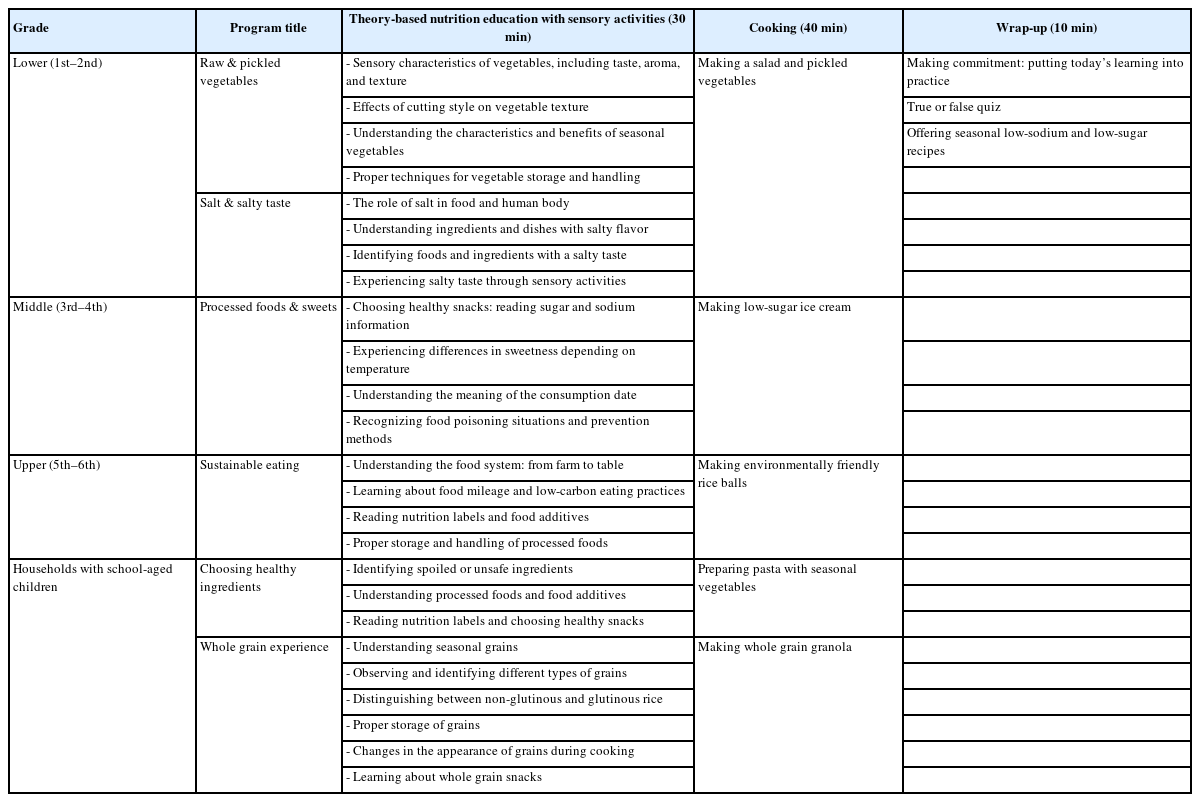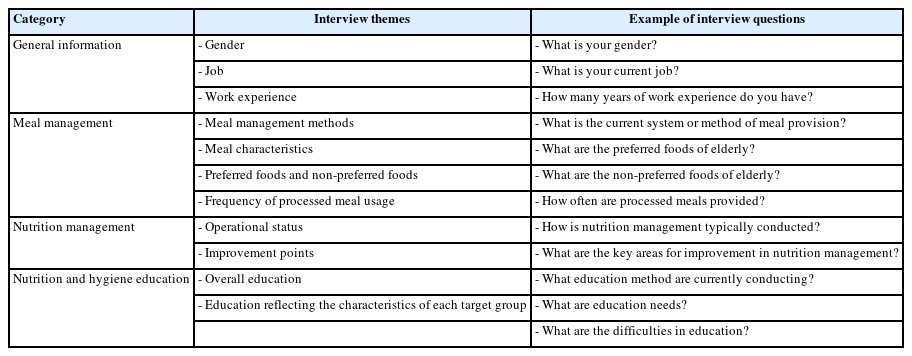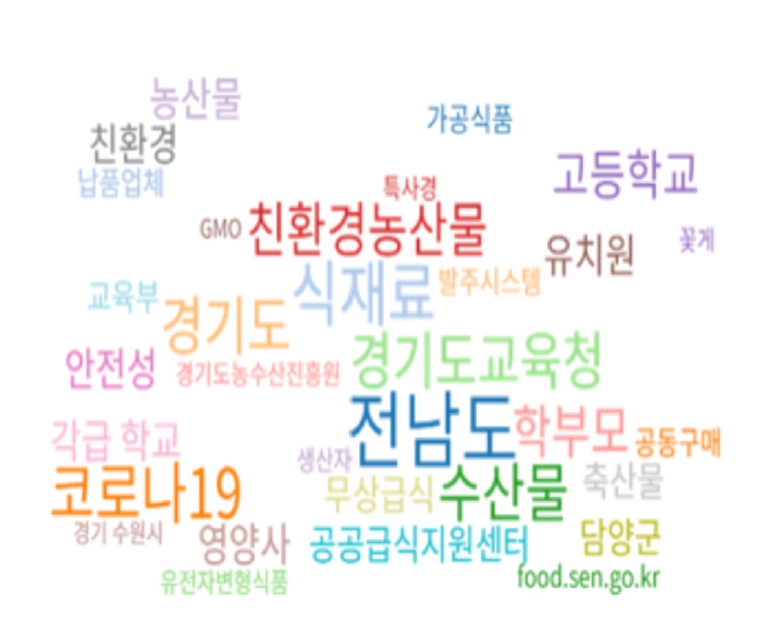Current issue
- Page Path
- HOME > Browse Articles > Current issue
Research Note
- [English]
- Pilot evaluation of a cooking-based nutrition education program to promote vegetable intake among children in Seoul, South Korea: a single-group pre–post study
- Sil-Ah Kim, Su-Jin Lee, Min-Ah Kim, Ji-Eun Oh, Sohyun Park, Hyun-Joo Ryou, Ji-Yun Hwang
- Korean J Community Nutr 2025;30(4):249-260. Published online August 29, 2025
- DOI: https://doi.org/10.5720/kjcn.2025.00220

-
 Abstract
Abstract
 PDF
PDF PubReader
PubReader ePub
ePub - Objectives
Food neophobia in children is often associated with limited exposure and familiarity to some foods. Cooking-based nutrition education (CBNE), which promotes acceptance through direct experience, may support the development of healthy eating habits. This study aimed to develop and implement a standardized CBNE program for school-aged children in Seoul, South Korea, and to evaluate its effectiveness by assessing changes in raw vegetable intake. Raw vegetable intake is an early indicator of the effectiveness of nutrition education on diverse topics in promoting healthy eating habits.
Methods
A single-group pre–post study was conducted with 37 children aged 6–11 years who participated in a 2-day CBNE program in October 2023. The participants completed pre- and post-education questionnaires and raw vegetable intake assessments. Four low-preference vegetables (bell pepper, carrot, cucumber, and tomato) were selected and served raw (25 g each) before and after the program. Intake changes were analyzed using paired t-tests, and Pearson’s correlation and hierarchical regression analyses were performed to identify predictors.
Results
Total raw vegetable intake significantly increased post-education (P = 0.008), particularly for carrots (P = 0.023). By subgroup, raw vegetable intake significantly increased in girls, upper-grade students, and those who consumed four or more vegetable side dishes per meal. Hierarchical regression analysis revealed that while vegetable preference was initially significant, vegetable-related experiences (β = 0.395, P = 0.026) and diversity of vegetable side dishes per meal (β = 0.403, P = 0.032) were stronger predictors in the final model (adj R2 = 0.333).
Conclusion
The CBNE program may enhance vegetable intake in children. Although preference remained the strongest individual factor, vegetable experience and the diversity of vegetable side dishes per meal had a greater combined effect. These findings underscore the importance of repeated and diverse exposure, not only by supporting previous studies that link such exposure to increased intake but also by suggesting that environmental support may be essential for sustaining healthy eating habits.
- 637 View
- 28 Download

Research Articles
- [English]
- Safety education status and needs priorities of Korean military food service personnel using the Borich Needs Assessment and the Locus for Focus model: a cross-sectional study
- Jeongeun Park, Eunsil Her
- Korean J Community Nutr 2025;30(4):261-273. Published online August 29, 2025
- DOI: https://doi.org/10.5720/kjcn.2025.00185

-
 Abstract
Abstract
 PDF
PDF PubReader
PubReader ePub
ePub - Objectives
Since the enactment of the Serious Accidents Punishment Act in Korea in 2021, the importance of safety management in food service facilities has increased. This study was conducted to examine the status of safety education and to identify educational needs for safety accident prevention among army food service personnel.
Methods
This study included 157 food service personnel from Army units located in Gyeongsangnam-do. Participants were divided into two groups based on the daily number of meals served. Demographic characteristics, the status of safety education, and priority for safety accident prevention education were evaluated.
Results
A total of 97.5% of participants received safety education, with 60.8% attending at least monthly. “Lecture” (63.4%) was the most commonly used educational method. The preferred educational methods were “Lecture” (23.5%) and “Counselling” (23.5%), showing significant group differences (P < 0.001). A total of 79.6% of participants reported applying the educational content in their performance. The mean importance score for safety accident prevention (4.78) was higher than the performance score (4.44), with significant differences between the two groups observed in the importance scores (P < 0.05). “Slip & burn” had the highest importance score, while “Electric shock and fire” had the highest performance score. The educational needs analysis revealed that the highest priority item for the < 100 meals group was “When moving heavy items, an assistive device or assistance from colleagues should be utilized”, while for the ≥ 100 meals group, it was “When using a vegetable cutter or grinder, use an exclusive stick.”
Conclusion
This study can serve as a foundational database for developing customized safety education programs tailored to Korean army food service personnel.
- 416 View
- 13 Download

- [English]
- Associations between diet quality and regional factors in Korea vary according to individuals’ characteristics: a cross-sectional study
- Hyunmi Han, Clara Yongjoo Park, Jeonghwa Lee
- Korean J Community Nutr 2025;30(4):274-285. Published online August 29, 2025
- DOI: https://doi.org/10.5720/kjcn.2025.00157

-
 Abstract
Abstract
 PDF
PDF Supplementary Material
Supplementary Material PubReader
PubReader ePub
ePub - Objectives
Although diet quality is known to be associated with environment and individuals’ characteristics, these have not been studied together. We determined the association of diet quality with regional factors stratified by individuals’ sociodemographic characteristics.
Methods
This study used nationally representative survey data on regional factors (2010–2020) and the Korea National Health and Nutrition Examination Survey data on individuals’ sociodemographic characteristics (2013–2018). Community-dwelling Koreans aged ≥ 20 were included (n = 26,853). Regions were categorized into metropolitan cities or provinces and subsequently according to regional factors (level of educational attainment, income per capita, food security status, physical activity facilities, time to the nearest large retailer, and internet use of the region). Individuals’ sociodemographic characteristics included age, education status, income, and number of household members. Diet quality was assessed using the Korean Healthy Eating Index (KHEI).
Results
In the entire population, education status of metropolitan cities was positively associated with the KHEI. Shorter time to retailers and higher internet use were positively associated with the KHEI in metropolitan residents with higher income levels but negatively associated with the KHEI in those with lower income status. Among provincial residents with a low education status or income, regional physical activity facilities were positively associated with the KHEI.
Conclusion
The association between diet quality and regional factors varied depending on the resident’s sociodemographic characteristics. Both regional and individual sociodemographic factors must be considered to address gaps in nutritional equity.
- 467 View
- 14 Download

- [Korean]
- A study on the diet and nutrition management status and educational needs in elderly care facilities in Korea: focus group interviews with staff from children’s and social welfare meal management support centers and elderly care facilities
- Seo Young Choi, Hyun joo Ryou, Jieun Oh
- Korean J Community Nutr 2025;30(4):286-295. Published online August 29, 2025
- DOI: https://doi.org/10.5720/kjcn.2025.00143

-
 Abstract
Abstract
 PDF
PDF PubReader
PubReader ePub
ePub - Objectives
In this study, we identified the current status of meal and nutritional management in elderly care facilities and analyzed the educational needs of employees, with the goal of proposing effective support strategies for nutritional management and to suggest directions for developing customized educational content.
Methods
Between May and June 2024, we conducted nine focus group interviews with 22 participants recruited from 10 cities across four major regions of Korea, including 13 employees of children and social welfare meal management support centers and nine employees of elderly care facilities.
Results
Our findings revealed that supporting algorithm-based dietary planning, improving communication with caregivers, and providing flexible, practical education tailored to facility conditions, are key elements for enhancing nutritional management in elderly care facilities. To facilitate the translation of these insights into practice, it will be necessary to strengthen collaboration between centers and facilities, combined with efforts to improve the operational environment for applying the algorithm and providing continuous educational support.
Conclusion
The findings of this study emphasize the importance of on-site education and sustainable support strategies based on the diet and nutritional management status and education needs of elderly care facilities. Strengthening practical education, communication systems, and center–facility collaboration is required, and future research needs to verify the efficacy of these measures and define a sustainable support system based on quantitative analysis.
- 450 View
- 23 Download

- [Korean]
- Analysis of the relationship between foodservice staffing and foodservice quality in elderly care facilities in Korea: a cross-sectional study
- Hyeonjeong Kim, Jinhee Kwon, Jungsuk Lee
- Korean J Community Nutr 2025;30(4):296-308. Published online August 29, 2025
- DOI: https://doi.org/10.5720/kjcn.2025.00122

-
 Abstract
Abstract
 PDF
PDF PubReader
PubReader ePub
ePub - Objectives
This study was performed to investigate the relationship between foodservice staffing and foodservice quality in elderly care facilities.
Methods
Data was obtained from the Korean Long-term Care Institute Database and used to analyze 2,084 elderly care facilities operating on-site foodservice. The presence of dietitians and staffing levels for cooking personnel were analyzed by categorizing size according to staffing criteria. Foodservice quality was assessed using food sanitation management and meal service provision as indicators. Descriptive statistical analysis, chi-square test, Fisher’s exact test, and Cochran-Mantel-Haenszel test were conducted to analyze relationships between staffing level and foodservice quality.
Results
Presence of a dietitian correlated with food sanitation management and meal service provision in groups with 30 or more recipients (P = 0.027, P = 0.049). Elderly care facilities with dietitians had better foodservice quality. After adjusting for size, the presence of dietitians was also found to correlate with food sanitation management (P = 0.024). Staffing levels for cooking personnel were found to correlate with meal service provision only in groups with 38 to 62 recipients. Institutions with larger staffs provided better meal service quality compared to those with basic staffing.
Conclusion
Inclusion of a dietitian and cooking staff size each contribute to enhanced foodservice quality in elderly care facilities, with dietitian inclusion showing a particularly significant association with food sanitation management. These findings suggest the need to revise current staffing and related regulatory standards to optimize deployment of foodservice personnel in elderly care settings. Future studies should focus on developing effective policies for securing qualified foodservice staff and establishing robust quality management systems to enhance overall foodservice quality in long-term care facilities.
- 358 View
- 15 Download

- [Korean]
- Survey on consumer perceptions, health benefits and preferences of kindergarten and school foodservices in Korea, including related keywords reported in newspaper: a mixed-methods study
- Gyoungok Gang, Chaewon Park, Hyeja Chang
- Korean J Community Nutr 2025;30(4):309-320. Published online August 29, 2025
- DOI: https://doi.org/10.5720/kjcn.2025.00199

-
 Abstract
Abstract
 PDF
PDF PubReader
PubReader ePub
ePub - Objectives
With the rapid development of social culture, the perception of kindergarten and school foodservice, as well as opinions on its health benefits, has changed significantly. However, research on this topic remains scarce. We conducted a survey in South Korea on consumers’ perceptions, healthiness, and preferences regarding kindergarten and school foodservice.
Methods
With the nationwide cooperation of 17 city and provincial education offices, online and offline surveys were conducted targeting the parents of kindergarten and lower-grade elementary school children, as well as upper-grade elementary, middle, and high school students. In addition, keywords in newspaper reports were analyzed using the Big Kinds platform. A total of 532 valid questionnaires were collected, and statistical analysis was performed using IBM SPSS Statistics version 27.0 (IBM Co.).
Results
The average age of the parents and students was 40 and 12.5 years, respectively, with 36.4% of the students attending schools in the Seoul and Gyeonggi areas. The main keywords reported in newspaper articles, as analyzed using the Big Kinds platform, were “eco-friendly agricultural products,” “food ingredients,” “safety,” and “marine products.” The perception of kindergarten and school foodservice was very positive, especially regarding the attributes of safe ingredient use (4.44), menu variety (4.29), cafeteria cleanliness (4.31), cleanliness of plates, spoons, and utensils (4.24), thorough hygiene management (4.2), nutritional excellence (4.24), and support for proper eating habits (4.18). The healthiness of school foodservice was highly rated, although there is still room for improvement in terms of “not serving fried foods more than twice a week”. In terms of preference for school meals, the most preferred items were meat side dishes, followed by chicken, noodles, fried food, beverages, and bread. In contrast, soybean paste soup, vegetables, and mixed-grain rice received relatively low preference.
Conclusion
The results described above may be used to develop educational programs or policies that inform students and parents about the goals of school foodservice and help address common misunderstandings.
- 567 View
- 17 Download


 KSCN
KSCN


 First
First Prev
Prev



